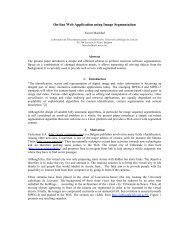motion estimation and compensation for very low bitrate video coding
motion estimation and compensation for very low bitrate video coding
motion estimation and compensation for very low bitrate video coding
You also want an ePaper? Increase the reach of your titles
YUMPU automatically turns print PDFs into web optimized ePapers that Google loves.
64 Chapter 2. Motion in the Framework of Video Coding<br />
x 0<br />
y 0<br />
!<br />
=<br />
=<br />
Cx cos x<br />
Cx sin x<br />
a1 a 2<br />
a 3<br />
a 4<br />
! x<br />
y<br />
,Cy sin y<br />
!<br />
Cy cos y<br />
+<br />
!<br />
a5<br />
a 6<br />
:<br />
!<br />
:<br />
x<br />
y<br />
!<br />
+<br />
tx<br />
ty<br />
!<br />
(2.30)<br />
The a ne trans<strong>for</strong>m results from the orthographic projection of the<br />
<strong>motion</strong> of a planar surface. Under perspective projection, an eightparameter<br />
perspective trans<strong>for</strong>m is built:<br />
x 0 = a 1 + a 2x + a 3y<br />
1+a 7x + a 8y ;<br />
y 0 = a 4 + a 5x + a 6y<br />
1+a 7x + a 8y :<br />
Another commonly used trans<strong>for</strong>m is the bilinear trans<strong>for</strong>m:<br />
x 0 = a 1x + a 2y + a 3xy + a 4<br />
y 0 = a 5x + a 6y + a 7xy + a 8<br />
(2.31)<br />
: (2.32)<br />
Higher level models also take into account acceleration e ects. Sanson<br />
[117] <strong>for</strong> instance proposes a twelve-parameter model:<br />
x 0<br />
y 0<br />
!<br />
=<br />
x ax ax y<br />
ay x<br />
ay y<br />
! x<br />
y<br />
!<br />
+<br />
x b 2<br />
x<br />
bx2 y<br />
bxy x<br />
bxy y<br />
by2 x<br />
by2 y<br />
! 0<br />
B<br />
@ x2<br />
xy<br />
y2 1<br />
C<br />
A +<br />
(2.33)<br />
Because of the presence of numerous moving <strong>and</strong> possibly overlapping<br />
objects in the scene, the above parametric models do not hold, in general,<br />
throughout the whole image plane. A solution to this problem<br />
is provided assuming that e<strong>very</strong> object is characterized by its <strong>motion</strong><br />
parameters. It leads to the \chicken-<strong>and</strong>-egg" combined segmentation<br />
& <strong>estimation</strong> problem. Away toovercome it is to use warping techniques<br />
(cf. Section 2.6) that have successfully implemented a matching<br />
methodology.<br />
2.4.6 Within a Trans<strong>for</strong>m Domain<br />
Estimation methods based on spatio-temporal lters over several pictures<br />
have recently been implemented. They are based on the property<br />
tx<br />
ty<br />
!<br />
:





